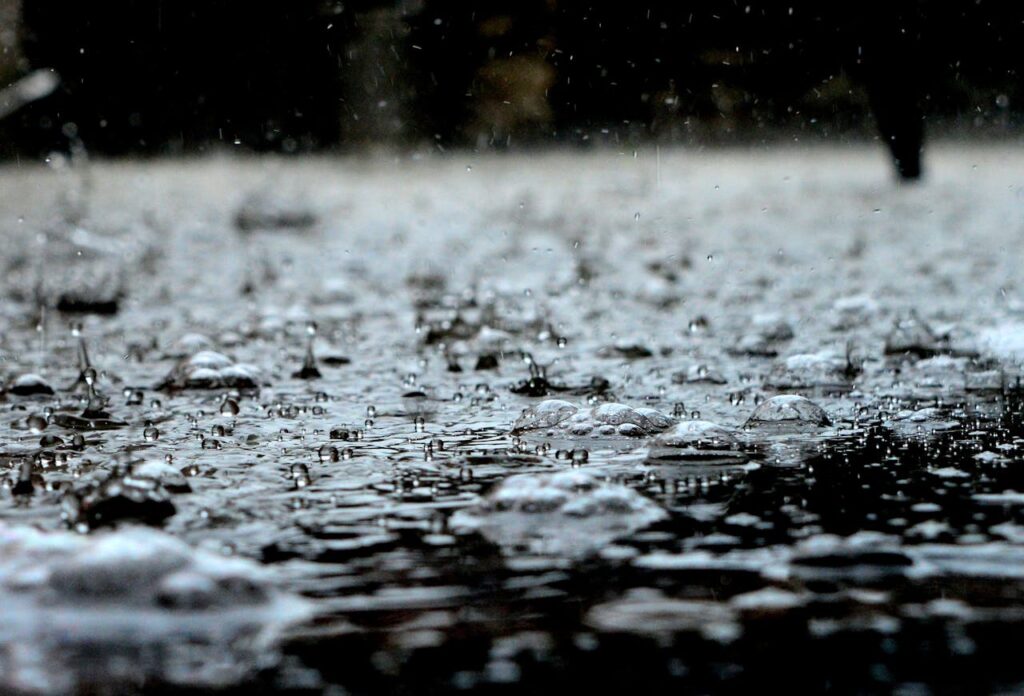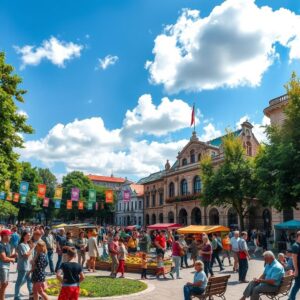
Explore & Play
Discover interesting topics and solve the accompanying crossword puzzle.
Shower crossword | Water cycle and its role in weather patterns
Table of Contents
Shower Crossword
You can either fill in the crossword puzzle directly on this page or click the button in the bottom right corner to print it for free.

The Water Cycle: From Evaporation to Precipitation
The water cycle is one of the most fundamental processes in Earth’s atmosphere, driving weather patterns that shape our world. It is a continuous movement of water within the atmosphere, from the surface to the air and back again. This cycle is crucial for maintaining life, regulating temperatures, and shaping climates. As water moves from oceans to the atmosphere, it interacts with other elements, influencing weather events like rainstorms, floods, and even hurricanes. In this article, we’ll explore the water cycle in detail, including its different stages—evaporation, condensation, precipitation, and runoff—and how each contributes to the creation of weather patterns.
To make the learning journey more engaging, we’ve created a crossword puzzle focused on weather and geography terms related to the water cycle, including words like “shower,” “monsoon,” “cloudburst,” and “precipitation.” Try playing the puzzle as you read, and you’ll notice how these terms connect to the water cycle.
I. The Water Cycle: An Overview
1.1 What is the Water Cycle?
The water cycle, also known as the hydrological cycle, involves continuous movement of water between the Earth’s surface and the atmosphere. This process begins with evaporation, where water from oceans, lakes, and rivers turns into vapor and ascends into the atmosphere. As this water vapor rises, it cools and condenses into clouds, which then produce precipitation—rain, snow, or other forms of water—that returns to the Earth’s surface. Some of this water collects in rivers and oceans, while the rest infiltrates the ground to form groundwater.
The cycle is driven by the sun’s heat, which causes evaporation, and by atmospheric conditions such as temperature and air pressure that influence condensation and precipitation. The result is a balance that sustains the planet’s water resources, influencing climates and weather patterns around the world.
1.2 The Stages of the Water Cycle
To understand the water cycle, we need to break it down into its key stages: evaporation, condensation, precipitation, and runoff. Each of these stages plays a critical role in the global movement of water.
Evaporation is the first step. When the sun heats bodies of water, it causes water molecules to become energized and escape into the atmosphere as vapor. In colder regions, ice sublimates, directly turning into vapor. As the vapor rises, it cools and condenses into liquid droplets, forming clouds. Once the clouds become heavy enough, they release the accumulated water as precipitation. Precipitation can take many forms, from gentle showers to violent storms.
After precipitation, the water flows over the ground in a process known as runoff, replenishing rivers, lakes, and oceans. Some of the water infiltrates the soil, where it either contributes to groundwater storage or eventually returns to the atmosphere through evaporation.
II. Evaporation: The Beginning of the Water Cycle
2.1 What is Evaporation?
Evaporation is the process by which water changes from a liquid to a vapor. It is the first crucial step in the water cycle, setting everything in motion. Evaporation occurs when the sun’s energy heats water in oceans, lakes, rivers, and even soil. This heat causes water molecules to move faster, breaking free from the liquid surface and entering the atmosphere as water vapor.
Evaporation is particularly common in tropical regions, where high temperatures and abundant water sources result in significant amounts of vapor. It is also the reason why tropical climates experience such high humidity, which in turn can lead to intense rainfall. For example, in the monsoon season, large amounts of water evaporate from the ocean, eventually forming clouds that bring heavy rains to land.
2.2 Factors Affecting Evaporation
Several factors affect how quickly water evaporates, including temperature, humidity, and air pressure. The hotter the water, the more energy it has to change into vapor. Humidity, on the other hand, plays an inverse role—higher humidity means that the air already contains a lot of water vapor, making it harder for more water to evaporate.
In areas with low humidity, such as deserts, evaporation is slower, and water sources may dry up quickly. Similarly, the air pressure can influence evaporation rates: lower pressure conditions, such as in mountainous areas, can result in faster evaporation as the water vapor rises more easily into the atmosphere.
III. Condensation: Formation of Clouds
3.1 How Clouds Form
As water vapor rises into the atmosphere, it begins to cool and condense into tiny droplets or ice crystals. This process forms clouds. The cooler temperatures at higher altitudes cause water vapor to lose its energy and form droplets that combine to create clouds.
The type of cloud that forms depends on the specific conditions, such as the temperature and pressure in the atmosphere. Clouds can vary in shape, size, and composition, from the fluffy cumulus clouds that bring fair weather to the dark, heavy cumulonimbus clouds that indicate thunderstorms and possible heavy rainfall.
3.2 The Role of Fronts in Cloud Formation
Clouds often form when two different air masses meet at a weather front, creating varying temperatures and pressures. For example, when a cold air mass collides with a warm one, the warm air rises, cools, and condenses into clouds. This process can lead to precipitation, including light rain showers or intense storms, depending on the severity of the front.
A warm front leads to the gradual rise of warm air, causing stratus clouds to form and often resulting in steady, prolonged rain. On the other hand, a cold front can bring sudden, heavy rainfall or even a thunderstorm due to the rapid lifting of warm air, producing more intense precipitation.
IV. Precipitation: The Fall of Water to the Ground
4.1 What is Precipitation?
Precipitation refers to any form of water that falls from the atmosphere to the Earth’s surface. This includes rain, snow, hail, and sleet, all of which play an essential role in distributing water across the planet. Precipitation occurs when water droplets or ice crystals in clouds combine and grow large enough to fall to the ground under the influence of gravity.
Rain is the most common form of precipitation, but in colder climates, snow and sleet are more common. Each type of precipitation depends on the temperature and atmospheric conditions at the time of the event.
4.2 The Types of Precipitation
The type of precipitation that reaches the ground depends on temperature, pressure, and humidity. In warmer climates, rain is the most common type of precipitation. When temperatures drop, the water droplets in the clouds freeze, resulting in snow. Sleet and hail are both forms of frozen precipitation, with hail occurring in thunderstorms when ice pellets are carried upwards in strong updrafts.
In tropical regions, monsoon rains are often accompanied by intense downpours that can lead to flooding, while polar areas experience snowfall due to the colder temperatures. Different climates, such as temperate, arid, or tropical, influence the frequency and intensity of various types of precipitation.
4.3 Extreme Precipitation: Flooding and Downpours
While precipitation is vital for life, extreme downpours and floods can cause widespread damage. Heavy rainfall, often caused by tropical storms, cyclones, or hurricanes, can lead to rapid runoff and overwhelming floodwaters. In urban areas, poor drainage systems can exacerbate the effects of heavy precipitation, leading to flash floods.
Downpours, common during thunderstorms and monsoons, can significantly affect agricultural areas, leading to crop loss and erosion. Such events highlight the need for effective water management strategies to cope with extreme precipitation.
V. Weather Systems That Affect the Water Cycle
5.1 Monsoons and Their Role in Precipitation
Monsoons are seasonal winds that bring heavy rainfall to tropical regions. These winds are driven by differences in temperature between the land and the ocean. During the monsoon season, warm air from the ocean rises, carrying moisture that condenses to form clouds and results in intense rainfall. Monsoons are crucial for replenishing freshwater supplies in many tropical regions, but they can also cause devastating flooding if rainfall is too heavy.
5.2 Cyclones and Hurricanes: Powerful Weather Systems
Cyclones and hurricanes are intense low-pressure systems that bring heavy rainfall, strong winds, and storm surges. These systems form over warm ocean waters and are powered by the release of latent heat as water vapor condenses into rain. When these systems move over land, they often result in heavy precipitation, flooding, and sometimes tornadoes.
Hurricanes, which are the Atlantic version of cyclones, have significant impacts on coastal areas, often bringing heavy downpours that lead to flooding. These storms are among the most powerful weather systems on Earth, and their intensity has been linked to rising sea temperatures due to climate change.
5.3 Tornadoes and Their Impact on Weather Patterns
Tornadoes, while smaller in scale than cyclones, have extremely powerful winds that can cause localized precipitation. Tornadoes often form in conjunction with thunderstorms, particularly in areas known for their unstable atmospheric conditions. As warm, moist air meets cold, dry air, it creates conditions ripe for violent weather, including tornadoes.
Tornadoes are typically short-lived but can be incredibly destructive, and their associated precipitation can lead to flash flooding in some cases.
VI. Water Runoff: The Final Stage of the Water Cycle
6.1 What is Runoff?
After precipitation, runoff occurs when water flows over the land and eventually returns to rivers, lakes, and oceans. This water, often called surface runoff, contributes to the replenishment of water bodies. Runoff is especially important in regions with high rainfall or melting snow, as it can significantly impact the availability of freshwater.
6.2 The Importance of Runoff in Flooding
Excessive runoff can lead to flooding, especially in urban areas where water cannot easily infiltrate the ground. Heavy rains from storms, cyclones, or monsoons can result in large amounts of runoff, overwhelming rivers and leading to widespread flooding. In some cases, poor urban planning and deforestation can exacerbate the effects of runoff, making flooding more severe.
VII. Climate Zones and Their Influence on the Water Cycle
7.1 The Tropics and High Humidity
Tropical regions are characterized by high humidity and frequent rainfall. The abundant water sources in these regions make them critical for understanding the water cycle. In tropical climates, evaporation rates are high, which leads to the formation of clouds and intense precipitation, particularly during monsoon season. This consistent cycle of evaporation and precipitation helps sustain the lush ecosystems found in tropical rainforests.
7.2 The Arctic and Its Unique Water Cycle
In contrast, the Arctic regions experience colder temperatures and lower evaporation rates. Ice and snow play a central role in the water cycle here, as frozen water is a major component of both evaporation and precipitation. The cold temperatures in polar regions result in the formation of snow rather than rain, which then accumulates on the ground.
VIII. The Impact of Climate Change on the Water Cycle
8.1 How Global Warming Affects Evaporation and Precipitation
Climate change is altering the delicate balance of the water cycle, affecting everything from evaporation rates to precipitation patterns. As global temperatures rise, more water evaporates from oceans, lakes, and rivers, leading to increased humidity. This extra moisture in the atmosphere can result in more intense precipitation, including heavy downpours and flooding in some regions.
Climate change also impacts the frequency and intensity of extreme weather events like hurricanes and monsoons. The increased evaporation due to higher temperatures has led to longer droughts in some areas, reducing freshwater availability and leading to water scarcity.
8.2 The Future of Water Resources and the Water Cycle
As the Earth’s climate continues to change, it is crucial to understand how the water cycle will evolve. Rising temperatures, changing precipitation patterns, and more extreme weather events threaten global water resources. It is essential that governments and communities work together to develop strategies for managing water in a more sustainable way to ensure that future generations have access to this vital resource.
Conclusion: Understanding the Water Cycle and Its Global Significance
In conclusion, the water cycle is a vital natural process that helps regulate weather patterns and sustain life on Earth. From evaporation to runoff, each stage plays a crucial role in maintaining the balance of water in our environment. However, the cycle is not immune to the impacts of climate change, which is causing shifts in weather patterns and threatening the availability of water resources. Understanding the water cycle is essential for adapting to these changes and ensuring a sustainable future.
As you continue to explore the wonders of nature, try out our crossword puzzle, which will test your knowledge of key terms related to the water cycle and weather systems. Enjoy learning and playing!
Share to...
I hope you enjoy the content.
Want to receive our daily crossword puzzle or article? Subscribe!
You may also be interested in
Share to…
Want to receive our daily crossword puzzle?
-
Jigsaw Puzzles
Chinese Zodiac Serpent Watercolor Jigsaw Puzzle 250 | 300 | 500 Pieces
kr 348,00 – kr 439,00Price range: kr 348,00 through kr 439,00 Select options This product has multiple variants. The options may be chosen on the product page -
Jigsaw Puzzles
Chinese Dragon Jigsaw Puzzle – Zodiac Series Art 250 | 300 | 500 Pieces
kr 348,00 – kr 439,00Price range: kr 348,00 through kr 439,00 Select options This product has multiple variants. The options may be chosen on the product page -
Jigsaw Puzzles
Charming Hamster Art Nouveau Jigsaw Puzzle 250 | 300 | 500 Pieces
kr 348,00 – kr 439,00Price range: kr 348,00 through kr 439,00 Select options This product has multiple variants. The options may be chosen on the product page

















